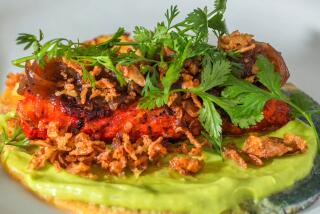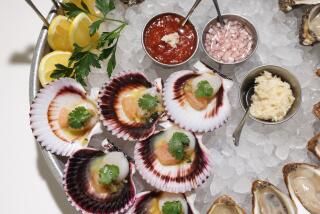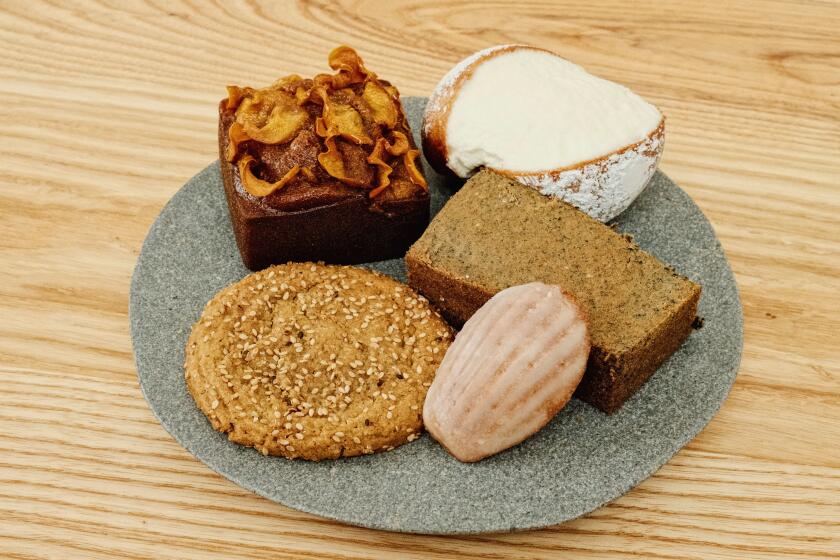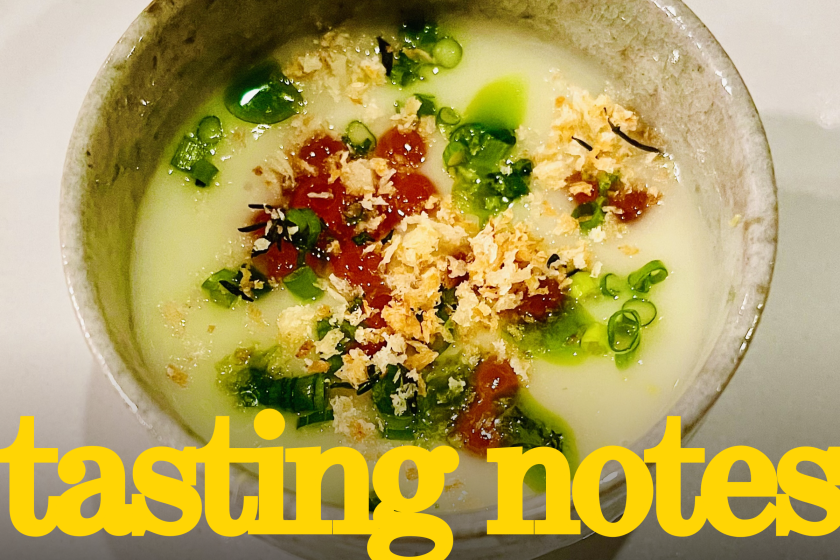Fusion Power
Filipino cooking might be Asia’s original fusion cuisine. After all, the Philippine Islands, inhabited by cousins of the Indonesians, have been colonized by Spain, greatly influenced by China and even annexed for a couple of decades by the United States. By now, fusion is simply tradition there.
Mangga Grill in Tustin tries to take the whole fusion thing even a little further; the chefs love to do Western-style riffs on classic Filipino dishes. As you eat their imaginative food at tables covered with white butcher paper, by the way, you’re hearing jazz from the ‘40s and ‘50s, not exactly the soundtrack you expect at an Asian restaurant.
In fact, little is typical about this place, apart from a few old-time Filipino dishes on the menu. And there are some delightful surprises among the fusion items.
Take the Oriental salad: light, crunchy greens mixed with jicama, sesame seeds, peanuts and fried noodles. It’s all in a tangy sweet-and-sour dressing, and the flavors mingle elegantly. Or take crispy spinach--leaves of spinach dredged in flour and deep-fried. They look like the world’s most wholesome potato chips. On top of that, I’ll bet you can’t eat just one. Go ahead and try.
Before you get too deep into the menu, though, be sure to order one of the exotic drinks. Kalamansi juice is described on the menu as Philippine lemon-lime, but that doesn’t do it justice. It’s sweet, complex and unbelievably refreshing on a hot summer day.
“Mangga” is the Tagalog word for mango, and Mangga Grill makes a doozy of a green mango shake from sliced mangos, ice and a touch of lemon juice. There’s also an orange-colored milkshake made with ripe mangos and a scoop of mango ice cream. It’s so thick and rich you’ll have to eat it with a spoon.
*
You’ll also use that spoon for the soups, which come steaming to the table in enormous white bowls. Sinigang is based on a tamarind broth, which is probably a touch too sour for people unused to it. The broth is generously stocked with the meat of your choice: shrimp, bangus (milkfish), beef or pork.
Bulalo soup, however, is not problematic at all. You get a big, meaty, marrow-filled beef shank, plus cabbage and bok choy, all in a clear, intense beef broth. Take out the bok choy and it would taste almost exactly like tafelspitz, the classic Viennese dinner of boiled beef and broth.
A few of the fusion dishes work wonderfully well. Pla-pla in banana leaves is tilapia that has been fried, then wrapped in leaves with a Spanish-style sofrito of tomatoes and onions, and then steamed, rendering the flesh of this sweet, bony fish wonderfully moist.
Inihaw na talong is charbroiled eggplant, served with a palate-cleansing salsa of chopped cucumbers and papayas. The honey-stung chicken, perhaps the best meat dish here, is broiled chicken that has been marinated in honey, white wine, Worcestershire sauce, garlic and Manila rum.
But it’s not as though the menu neglects the more traditional Filipino dishes. To give just one example, Mangga Grill makes one of the best adobos I’ve ever tasted. Adobo is chicken or pork stewed with vinegar and soy sauce until the meat turns a dark chocolate brown and becomes meltingly tender to boot. Try the hearty mixed adobo, which marries big chunks of pork with chicken literally falling off the bone; it’s wonderful with steamed rice.
One of the most distinctive dishes is pinakbet, a delicacy from the island of Ilocos. Pinakbet is a stew of mixed vegetables, pork and bitter melon--a squash that looks like a cross between a cucumber and a horned toad. For this version, the melon has been soaked to reduce its bitterness, and the result is a treat.
Another traditional dish is kare-kare: eggplant, long beans and oxtail in a sauce thickened with peanut butter. It’s quite a heavy dish, and you’re supposed to eat it with bagoong, a pungent shrimp paste that I’d call a slowly acquired taste.
Mangga Grill’s crispy pata has a wide following. This is a deep-fried pork shank with crisp skin on the surface, like pork with lots of cracklings or chicharrones. The twist is the sweet sauce that comes on the side--it’s made from pureed pork liver. At first taste, it’s weird, but as you eat it with the pork, it kind of grows on you.
A range of good rice and noodle dishes complement these heavy hitters. Pancit are wispy fried rice noodles with a variety of toppings. Sotanghon is the slippery, translucent bean thread noodles referred to as glass noodles in Thai restaurants. Here they’re topped with sauteed chicken, mushrooms and vegetables.
Don’t miss the exotic desserts, especially a pair with double names, sapin-sapin and halo-halo. Sapin-sapin (literally, layer-layer) is the answer to the question “What’s purple and orange and white all over?” It’s a sweet cake of pounded rice cut into wedges, with a top layer made from purple yams (ube).
The better known halo-halo is a variety of fruits and confections served in a parfait glass with shaved ice. Mangga Grill makes the most deliciously indulgent version I’ve ever tasted. The chefs layer the glass with ice, thick custard (leche flan), young coconut (buko), pearls of sago from the tapioca plant, mango slices, corn kernels, jackfruit and (the capper) a scoop of radiant purple extra-creamy ice cream made from those ube yams.
The only thing packing more fusion per bite is an H-bomb.
Mangga Grill is moderately priced. Appetizers are $4.95 to $6.95. Soups are $6.95 to $13.95. House specialties are $9.95 to $27.95. Desserts are $2.45 to $3.75.
BE THERE
Mangga Grill, 341 E. 1st St., Tustin. (714) 730-1332. Open 11 a.m.-10 p.m. Tuesday-Friday, 9 a.m.-10 p.m. Saturday-Sunday. All major cards.
More to Read
Eat your way across L.A.
Get our weekly Tasting Notes newsletter for reviews, news and more.
You may occasionally receive promotional content from the Los Angeles Times.










